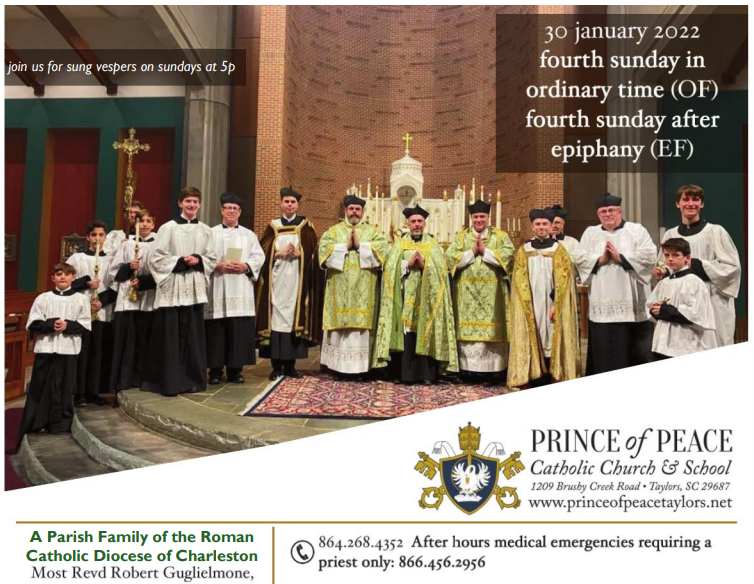
30 January 2022 Bulletin
Click to read this week’s bulletin: 30 January 2022

Click to read this week’s bulletin: 30 January 2022
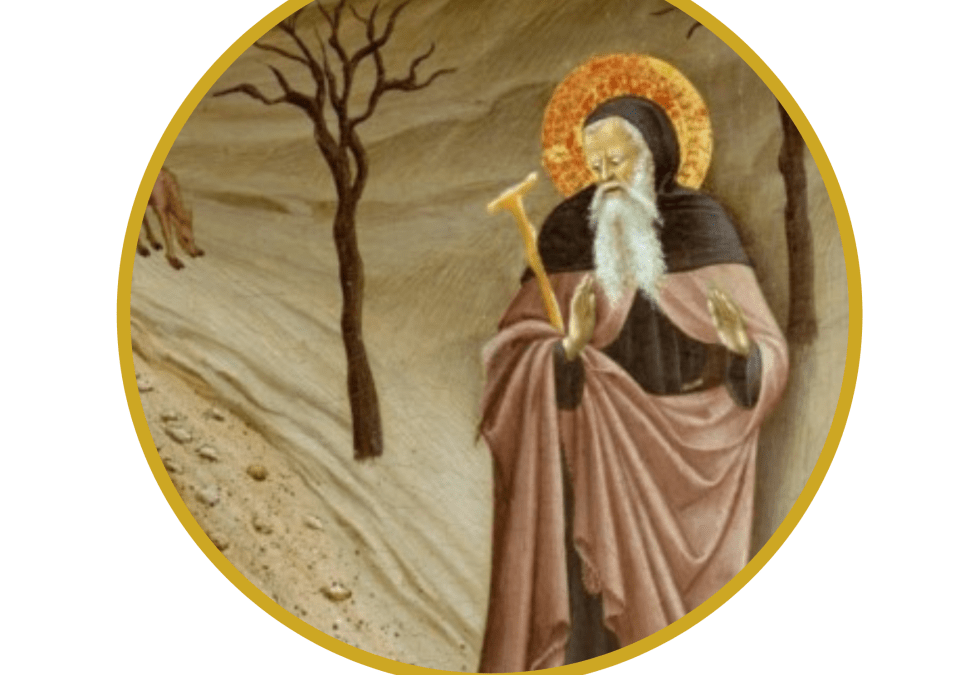
17 January: Feast of Saint Anthony. Known as Saint Anthony “the Great” and the “Father of Monks”, he was born in Egypt around the year 250 to distinguished parents. After their untimely deaths, he dedicated himself wholly to acts of mortification. One day in church (around age 18) he heard the words of the Gospel: “If you wish to be perfect, go, sell what you have, and give it to the poor” (Matt. 19:21). Anthony felt as if Christ had spoken to him personally, giving a command he must obey. Without delay he sold his property, gave the proceeds to the poor, and went into the desert. He chose an inaccessible place in the wilderness where he dedicated his life to God in manual work and continual prayer. He lived in solitude for over 20 years. His bed was the hard ground. He fasted rigorously, ate only bread and salt, and drank only water. He would not take food before sundown; at times he passed two days without any nourishment. He often spent whole nights in prayer. In his older age, he imparted wisdom to a group of disciples and encouraged them to lead a monastic life. Because he was the first Christian to retire to a monastic life, he is considered to be the first monk and also the father of all monks. Anthony suffered repeatedly from diabolical attacks, but these merely made him more steadfast in virtue. He would encourage his disciples in their struggle with the devil with such words: “Believe me; the devil fears the vigils of pious souls, and their fastings, their voluntary poverty, their loving compassion, their humility, but most of all their ardent love of Christ our Lord. As soon as he sees the sign of the Cross, he flees in terror.” He died in 356 on Mount Kolzin by the Red Sea, at the age of 105. A year later his friend, the fearless bishop and confessor St. Athanasius, wrote his biography, which for centuries became the classic handbook of ascetics. He describes how St. Anthony saw the purpose of asceticism as not to destroy the body but to bring it into subjection, re-establishing man’s original harmonious integrity, his true God-given nature: “His was a perfectly purified soul: no pain could annoy him, no pleasure bind him. In him was neither laughter nor sadness. The sight of the crowd did not trouble him, and the warm greetings of so many men did not move him. In a word, he was thoroughly immune to the vanities of the world, like a man unswervingly governed by reason, established in inner peace and harmony.”
Saint Anthony famously taught his monks: “Let it be your supreme and common purpose not to grow weary in the work you have begun, and in time of trial and affliction not to lose courage and say: Oh, how long already have we been mortifying ourselves! Rather, we should daily begin anew and constantly increase our fervor… And that we may not become weary and disheartened, it is good to meditate on the words of the apostle: ‘I die daily.’ If we live with the picture of death always before our eyes, we will not sin… For our life is by nature uncertain and is daily meted out to us by Providence. If we are convinced of this and live each day as the apostle suggests, then we will not fall into sin; no desire will enslave us, no anger move us, no treasure bind us to earth; we will await death with unfettered hearts.”
Ideas for celebrating this feast at home:
(Sources: exerpts from The Church’s Year of Grace by Pius Parsch; catholicculture.org)
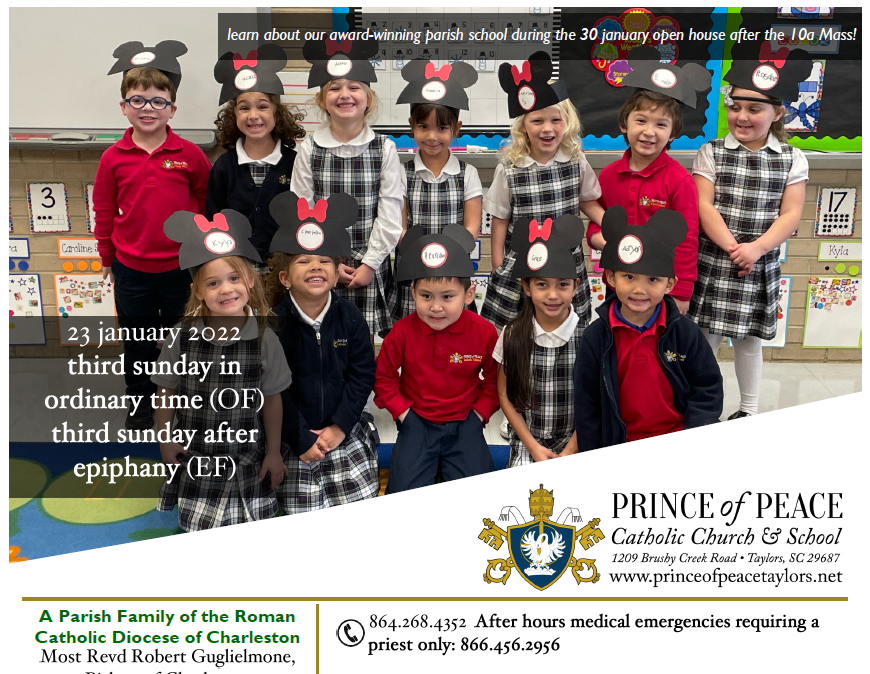
Click to read this week’s bulletin: 23 January 2022. Changes to the schedule are noted here.
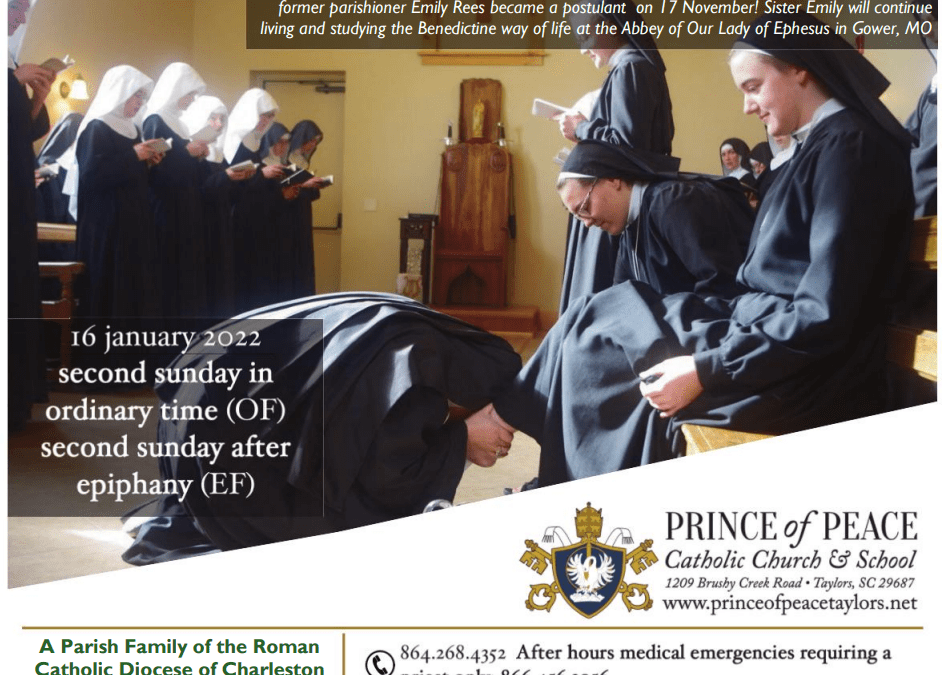
Click to read this week’s bulletin: 16 January 2022. Check our page for schedule changes to see the latest news.
Saturday Afternoon, 15 January
Sunday, 16 January
Monday, 17 January
Tuesday Afternoon, 18 January
Please remember that we close the church due to expected inclement weather for a number of safety related reasons: the Fathers do not live on campus, but on the top of a hill where the road is usually not snowplowed or cleared of ice; ice storms north of I-85 and 385 often cause power outages which mean no electricity or water, downed trees and power lines on and near campus; etc. Thank you in advance for your understanding.
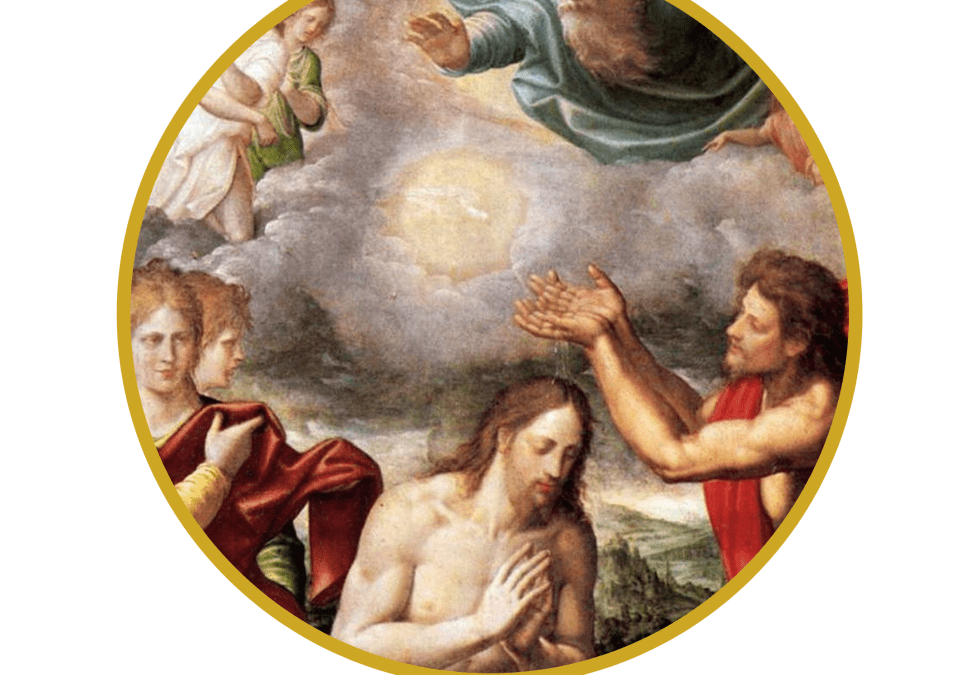
8 January: Feast of the Baptism of the Lord. Today, we celebrate the baptism of Christ in the Jordan by John the Baptist: a milestone event in the life of Jesus and in Christianity. This feast day is usually celebrated on the Sunday after the Feast of the Epiphany. It brings to an end the liturgical season of Christmas. {Christmas is the feast of God’s self-revelation to the Jews, and Epiphany celebrates God’s self-revelation to the Gentiles.} At his Baptism, Christ reveals himself again, this time to repentant sinners. The Baptism of Jesus also marks the first public revelation of all Three Persons in the Holy Trinity, and the official revelation of Jesus as the Son of God to the world by God the Father. Jesus’s baptism is described in all four Gospels and it marks the beginning of his public ministry. “After Jesus was baptized, he came from the water and behold, the heavens were opened [for him], and he saw the Spirit of God descending like a dove [and] coming upon him. And a voice came from the heavens, saying, ‘This is my beloved son, with whom I am well pleased’ ” (Mt 3:16-17). We know that Jesus, holy and sinless, did not need to be baptized. Yet he humbled himself and submitted to his Father’s will. Jesus’s baptism sanctified the waters and instituted the Sacrament of Baptism. The Catechism of the Catholic Church states: Our Lord voluntarily submitted himself to the baptism of St. John, intended for sinners, in order to “fulfill all righteousness.” Jesus’ gesture is a manifestation of his self-emptying. The Spirit who had hovered over the waters of the first creation descended then on the Christ as a prelude of the new creation, and the Father revealed Jesus as his “beloved Son.” (CCC 1224) Fr. Antony Kadavil explains this further: “Neither John nor Jesus invented baptism. It had been practiced for centuries among the Jews as a ritual equivalent to our Confession. Until the fall of the Temple in 70 A.D., it was common for Jewish people to use a special pool called a Mikveh – literally a “collection of water” – as a means of spiritual cleansing. Men took this bath weekly on the eve of the Sabbath; women, monthly. Converts were also expected to take this bath before entering Judaism. The Orthodox Jews still retain the rite. John preached that such a bath was a necessary preparation for the cataclysm that would be wrought by the coming Messiah. Jesus transformed this continuing ritual into the one single, definitive act by which we begin our life of Faith. In effect, He fused His Divine Essence with the water and the ceremony. In this humble submission, we see a foreshadowing of the “baptism” of his bloody death upon the cross. Jesus’ baptism by John was the acceptance and the beginning of his mission as God’s suffering Servant. He allowed himself to be numbered among sinners. Jesus submitted himself entirely to his Father’s will. Out of love, He consented to His baptism of death for the remission of our sins.” On this glorious feast day, we also celebrate our own baptisms, which freed us from sin and made us sons and daughters of God. Through baptism, God has opened the doors to Heaven. Deo gratias!
Ideas for celebrating in your home:
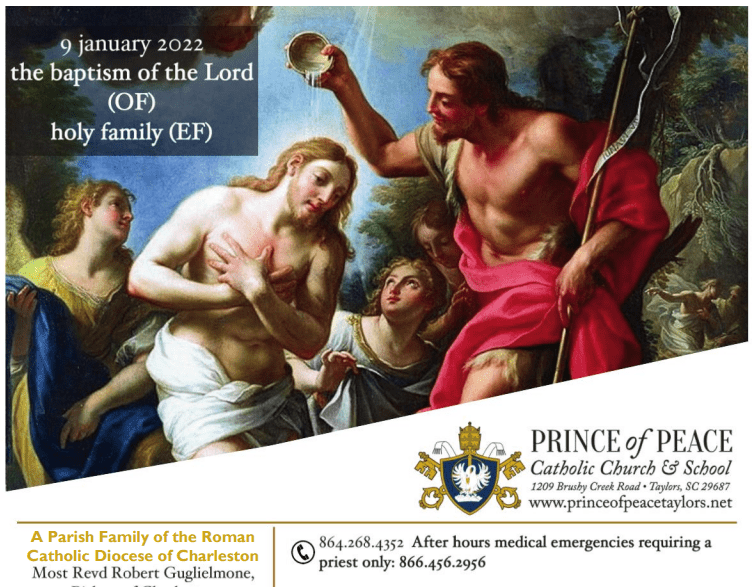
Click to read this week’s bulletin: 9 January 2022
The Solemnity of Mary, Mother of God is a holy day of obligation. Our Mass schedule is:
*EF = Extraordinary Form
Did you know that the Feast of the Epiphany on 6 January, known in the English speaking world as the Twelfth Night of Christmas, is actually far older than Christmas itself, and for centuries was celebrated with eight days, an Octave, of feasting afterwards? The Epiphany comes from a Greek word meaning manifestation and actually commemorates three manifestations of the Divinity of Christ: when the Wise Men give gifts fit for a king and a deity to the Christ Child, when Jesus was baptized by John in the Jordan and the Father from heaven confirms His divine sonship; and the first miracle of Jesus at the Wedding at Cana. There are numerous customs of Catholic culture associated with Epiphany, and this year at Prince of Peace, we are going to celebrate as many as we can both in our parish church and in your domestic church.
2 January – Sunday: the Transferred Solemnity of the Epiphany in the Ordinary Form
8a Low Mass in English
10a The Proclamation of the Movable Feasts of the Year of Our Lord 2022 and Solemn Mass of the Epiphany in English
2 January – Sunday: the Feast of the Holy Name in the Extraordinary Form
12N Low Mass in Latin
5 January – Wednesday: the Vigil of the Epiphany
12N Low Mass EF in Latin
6 January – Thursday: the Traditional Feast of the Epiphany in the Extraordinary Form
6.30p Solemn Blessing of Epiphany Water, Chalk, Gold – Frankincense – Myrrh
7p Solemn High Mass of the Epiphany
8p Royal Procession to the Epiphany Crib and Benediction of the Most Blessed Sacrament
8 January – Saturday
6p Blessing of the Great Nativity and Prosecco Toast for Donors
6p Epiphany Party & Potluck Dinner for Our Parish Family
On the Feast of the Epiphany in the Domestic Church you are invited to do the following:
On the Traditional Feast of the Epiphany, 6 January, we encourage you to come to the evening liturgy and bring with you the following to be blessed by placing them on the table provided in the sanctuary within the Communion rail:
In Catholic cultures, it was common for the parish priest and the altar servers to go to door in the parish boundaries with blessed Epiphany Water during the Octave of the Epiphany and bless every house in the parish. Because of the size of our territory and the number of parishioners who live outside the territory, that is impossible at Prince of Peace, but you may bring home the water you have blessed at church, mix the salt into it, and sprinkle the inside and outside of your homes and workplaces.
The Eastern Catholic Traditions
To learn more about these amazing Epiphany customs, please read the following:
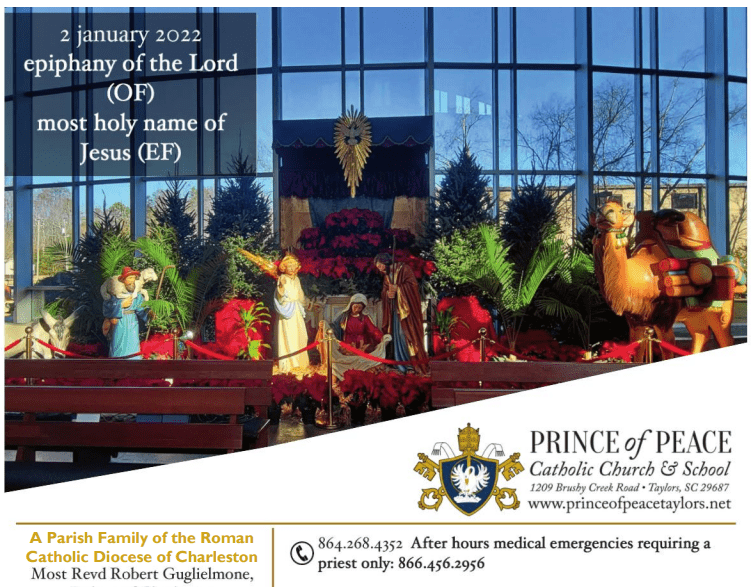
Click to read this week’s bulletin: 2 January 2022
*note the Wednesday Mass is at 8.30a, not 9a
Recent Comments